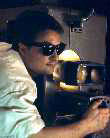|
|
 
|
|
Author
|
Topic: Film handling methods - history.
|
Stephen Furley
Film God

Posts: 3059
From: Coulsdon, Croydon, England
Registered: May 2002
|
 posted 01-08-2003 03:16 PM
posted 01-08-2003 03:16 PM




The recent debate about the merits of various film handling methods had me wondering about the history of each. I know that 1000 foot spools were in use within a few years of the invention of film, but when were 2000 foot spools introduced for projection, and when did prints start getting sent out to cinemas in this form?
In the uk, the regulations required spool boxes constructed so as to contain no more than 2050 feet of film in nitrate days, so 6000 foot spools must have been introduced after safety film, but I think not long after, I have seen 1950s projectors with 6000 foot boxes, which I think are original, though not common at that time. were they introduced any earlier elsewhere?
I have no idea of when towers were introduced, does antone else know?
Large spools (12-15000 feet) on the carried on the projector itself have been around since at least the early '70s. Has any one seen any older than this? They obviously could not have been used before the introduction of xenon lamps. I have seen projectors of this type made by Philips and Fedi, both having one spool on each side of the base, Cinemeccanica, with both spools on the operating side, but overlapping, and the Kinoton FP-30 is available with large spools in the conventional position, one above the other. Are large spools like this a European thing?
The earliest platter I have seen dated from about about 1973, were there any before this?
What about endless loop platters, The only place I have seen these was at the now closed Museum of the Moving Image, in London, are they used in any conventional cinemas?
I have seen a couple of towers which were dual guage, but both were in 35mm only cinemas. Is anywhere actually running 70mm on a tower? A full spool of 35mm is about as much as I can lift onto a tower, I'm sure 70mm would be a two man job.
| IP: Logged
|
|
|
|
|
|
|
|
|
|
|
|
|
|
|
|
|
|
|
|
|
|
Leo Enticknap
Film God

Posts: 7474
From: Loma Linda, CA
Registered: Jul 2000
|
 posted 01-13-2003 01:57 AM
posted 01-13-2003 01:57 AM





Stephen writes:
quote:
What about endless loop platters, The only place I have seen these was at the now closed Museum of the Moving Image, in London, are they used in any conventional cinemas?
I hope not. I worked at MOMI and ran these platters, and we all hated them. They constantly jammed and the prints wore out so quickly that they had to be replaced about every six months. The idea was a pre-digital way of getting rid of projectionists: your average town centre three-screen (so the theory goes) would be visited by a projectionist every week who would change the programmes, which would be started simply by pressing a button in the manager's office. From what I was told they proved totally unreliable when used in this way, and when managers were repeatedly faced with a pile of film on the floor and the prospect of handing out hundreds of refunds, the idea was dropped. From then on, these platters were only used in special venues such as the MOMI exhibits.
Also at MOMI, we ran a 1940s 16mm endless loop platter attached to an RCA projector built into an early 'video jukebox' called a Panoram. The projector and platter sat on the base of the unit, with the picture bring projected through a series of mirrors onto a back-projection screen mounted at shoulder height. This was for the history of the pop video exhibition in I think, '91 or '92. I remember that it kept throwing a new triacetate print that was made of a few Soundies. Working on the basis that the propionate stock used for 16mm prints in those days would have been thinner than modern triacetate, we got a polyester print made and it worked a treat.
| IP: Logged
|
|
|
|
All times are Central (GMT -6:00)
|
|
Powered by Infopop Corporation
UBB.classicTM
6.3.1.2
The Film-Tech Forums are designed for various members related to the cinema industry to express their opinions, viewpoints and testimonials on various products, services and events based upon speculation, personal knowledge and factual information through use, therefore all views represented here allow no liability upon the publishers of this web site and the owners of said views assume no liability for any ill will resulting from these postings. The posts made here are for educational as well as entertainment purposes and as such anyone viewing this portion of the website must accept these views as statements of the author of that opinion
and agrees to release the authors from any and all liability.
|

 Home
Home
 Products
Products
 Store
Store
 Forum
Forum
 Warehouse
Warehouse
 Contact Us
Contact Us




 Printer-friendly view of this topic
Printer-friendly view of this topic






![[Eek!]](eek.gif)




![[Smile]](smile.gif)






